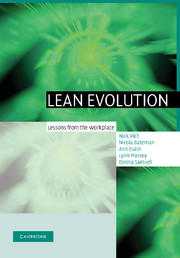Book contents
- Frontmatter
- Contents
- List of boxes
- List of figures
- List of tables
- Glossary
- 1 Introduction
- 2 Understanding the lean journey
- 3 Understanding your organisation
- 4 Laying the foundation stone of CANDO
- 5 Visual management and performance measurement
- 6 Problem solving, TQM and Six Sigma
- 7 Pull systems
- 8 Total productive manufacturing (TPM)
- 9 Sustainability
- 10 Group learning
- 11 Reflections and future challenges
- References
- Index
5 - Visual management and performance measurement
Published online by Cambridge University Press: 17 August 2009
- Frontmatter
- Contents
- List of boxes
- List of figures
- List of tables
- Glossary
- 1 Introduction
- 2 Understanding the lean journey
- 3 Understanding your organisation
- 4 Laying the foundation stone of CANDO
- 5 Visual management and performance measurement
- 6 Problem solving, TQM and Six Sigma
- 7 Pull systems
- 8 Total productive manufacturing (TPM)
- 9 Sustainability
- 10 Group learning
- 11 Reflections and future challenges
- References
- Index
Summary
Introduction
The ‘art’ of designing a fully effective lean production system requires attention to detail and a keen eye on the standardisation of processes in a manner that makes working life simpler and better for those who work in the factory (Grief, 1991). On first encounter with a system that has been implemented with full visual management practices, observers find it a contradiction, the almost-clinical approach to the design of the workplace seems to conflict with the high premium lean manufacturers place upon team autonomy. In reality, there is no contradiction because visual management creates a standard which allows ‘abnormality’, in whatever form, to be detected quickly and frees the worker from thinking about the basics of good management in favour of applying thought processes to more important matters of improvement. It looks simple in operation but visual management is an art in itself and a lesson that is well worth learning as it provides a path for problem-solving and improvement activities in a way that can be sustained due to its simplicity and ‘ease of doing’ on a daily basis.
Examples of good visual management surround us all – the red markings on the rev counter on the dashboard of your car and the level markings on the side of your kettle to avoid overfilling, and even the different colours of fire extinguishers are just a few.
- Type
- Chapter
- Information
- Lean EvolutionLessons from the Workplace, pp. 80 - 94Publisher: Cambridge University PressPrint publication year: 2006



